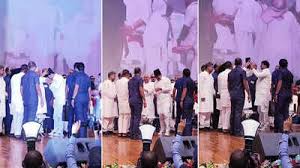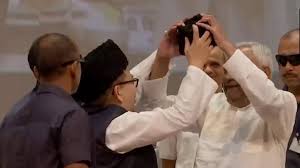Synopsis: Nitish Kumar ‘Cap’ controversy at Bihar Madrasa event triggers political debate, raising questions on his secular image, minority outreach, and alliance strategy with BJP.
Qalam Times News Network | Patna, August 22, 2025

A recent video of Bihar Chief Minister and Janata Dal (United) president Nitish Kumar refusing to wear the ”Topi” offered to him at the centenary celebrations of the Bihar State Madrasa Education Board and instead giving it to his minister Mohammad Zama Khan has become politically and socially significant.
The incident comes at a time when the election atmosphere in Bihar is hot and all political parties are eyeing the minority population of over 18 per cent. The move has raised several questions: Is Nitish Kumar now on an anti-Muslim agenda? Is he moving towards adopting the Modi-Yogi model? Or is it just a strategic move?
This contradictory aspect is evident when one looks at Nitish Kumar’s political life. In 2013, he had said that to run the country, a leader should “wear both cap and tilak,” a clear reference to Narendra Modi, who was then the Chief Minister of Gujarat and was refraining from wearing the Muslim cap. Nitish Kumar then parted ways with the BJP in protest against Modi’s candidature for the post of Prime Minister.
But now, 12 years later and several political twists and turns, he is back in alliance with the Narendra Modi-led BJP. His decision not to wear a skullcap at a madrasa ceremony could be seen as mere anti-minority sentiment or personal vacillation, or it could be construed as an electoral strategy.
It is hard to draw any simple conclusions, but Nitish’s move has been criticised by some Muslim teachers and the public. Teachers at the ceremony were protesting over salary arrears, and the chief minister only referred to achievements of earlier years. “He was talking about 2005 and 2006. The world has moved on fast. We expected him to pay attention to our current problems,” said a teacher. This shows that some sections of the minority community feel disappointed with Nitish Kumar’s policies.
JD(U) MLC Khalid Anwar defended Nitish’s role, saying he had enhanced the respect of the minority community and made them proud by making his minister Zama Khan wear his “Mukut”(Topi).The Chief Minister himself does not wear the cap, and making someone else wear it, is the insult to the sentiments of the Muslim community. this is a direct anti-Muslim gesture by Bihar CM.
Nitish Kumar has always been seen as a secular leader who has made several efforts for the rights of the Muslim community. Equalizing the salary of teachers in madrasas with that of government schools and working on the rights of Muslim women are examples of his previous tenure. But this action also raised the question whether Nitish Kumar is slowly moving towards the Modi-Yogi model, in which a strategy is adopted to ignore or symbolically alienate the minority vote bank.
This step may have been taken due to the compulsion of alliance with BJP. It is now difficult to show any clear minority bias or support in the politics of BJP and JD(U), especially in the election year. This step of Nitish Kumar can also be a symbol of his political stability and responsibility towards the alliance. But, if it is seen as anti-Muslim or an election strategy, then it can have a negative impact on his image.
There is also a deep social message hidden in this matter.The incident of not wearing the cap has raised the question whether communal thoughts are gradually increasing in Bihar politics as well. Are leaders like Nitish Kumar, who were earlier a symbol of secularism and minority rights, now doing such politics for the sake of political security and alliance, which can hurt the sentiments of the minorities?
In this context, the critics who called Nitish Kumar’s politics ‘flip-flop’ seem to be proved right. First anti-Modi, then BJP’s ally, and now distance from minority symbols – this points to a clear political flattery or strategy. It is also possible that this move is only electoral symbolism, not a real policy change. But even in the politics of symbolism, the message is important, and it can have an impact.
It is clear that Nitish Kumar has given a signal both politically and socially by not wearing a cap at the madrasa event. This move can question his secular image and Muslim support. Is he following the Modi-Yogi model, or is it just alliance politics – only time and election results will tell. But, this incident proves how challenging it is to maintain a balance between symbolism and minority sensibilities in politics.







